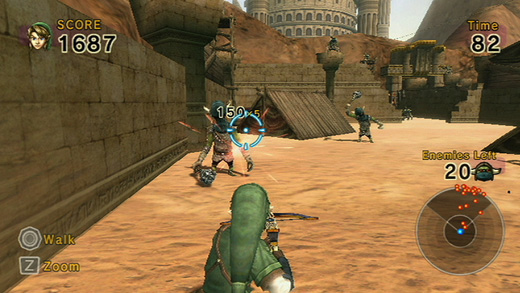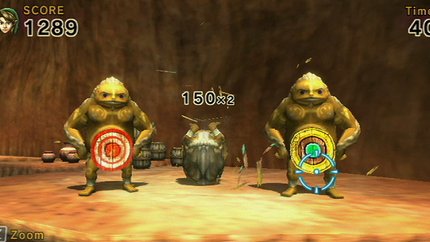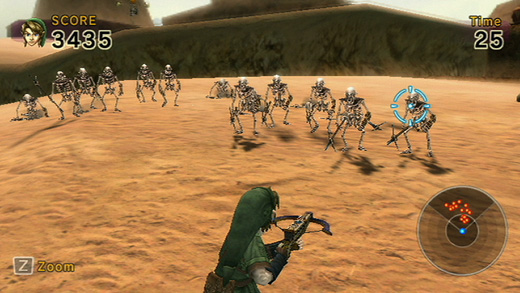At that time Jesus said, “I praise You, Father, Lord of heaven and earth, that You have hidden these things from the wise and intelligent and have revealed them to infants.
Matthew 11
Link’s Crossbow Training represents a strange, but interesting, decision from Nintendo to turn their Wiimote innovation into exactly what it looks designed for – pointing and clicking. So why not turn the whole shebang into a non-offensive, all-white, stylish gun-like device, right?

Like usual, Nintendo’s product improves upon the original design of so-called “light guns”. Holding a pistol with two hands satisfies, but keeping your aim study always remained a problem for someone not trained in law enforcement and/or criminal activity. Being able to stabilize your shots with the other hand, as with a rifle or shotgun, works wonder for precision aiming and fast shooting.
Inadvertently, of course, they also revived a stagnant genre for a time. You see, children, the advent of HDTVs came with many good things, but also made it impossible for light guns to work. Many a night in the Oliver house consisted of watching bad voice acting and shooting zombies in the Sega classic House of the Dead 2, and my Dreamcast light guns fell out of use when we finally upgraded. Sad to see it go, Nintendo brought it back to us (though not without some quirks).
Even so, you’d imagine that the Wii Zapper would attract games all on its own. Still, the company decided to reuse assets from the recent (at the time) Legend of Zelda: Twilight Princess to produce a strange target shooting game called Link’s Crossbow Training. Packaged with the new peripheral, it sought to show, at the least, the possibilities inherent in the device. Showing a knack for iterative design, Nintendo crafted quite an excellent “pure game” experience, skimping on neither fun, variety, or challenge in shooting things. See, you don’t need blood and gore, just visceral action to compensate. It works here quite well!
As you know, shooting things can easily turn into a rout action that one performs over, and over, and over again without any thought put into the process. Sure, Assault Rifle #1 feels slightly different than Assault Rifle #2, but does the “realism” in design make them fun or interesting in a video game? I’d say not by definition. You need to work hard in order to make such a simple game fun, and Link’s Crossbow Training accomplishes this in a number of ways.
First, most challenges fall into four distinct categories. The most traditional of the lot, Target Shooting (as I will call it), puts you through a static series of target shooting in many contextless Zelda locales (it’s been a while since I saw the end of Twilight Princess, quite honestly) with lots of variety. Shoot red targets, shoot yellow and green targets, but don’t shoot blue crosses. Simple enough, right? But each play switches the locations of these, forcing you to adapt, however subtly, for each sequence. A zoom-in feature makes hitting certain targets easier, but it limits your point of view for new targets appearing – thus, it provides a risk for reward.
Unlike most shooting games, Link’s Crossbow Training wants you to shoot slowly and accurate. Points awarded for each targets seem based on size and color, red being worth the least and yellow worth the most. Continuous accurate shots will net you a multiplier increase in your score to the tune of one per successful shot. Missing a target, or shooting on a non-point giving target (fairly obvious at all time) will make you lose the multiplier.
This design decision looks warranted just by the nature of the Wii’s motion sensing capability. Given that the Wii cannot instantly measure your gun movements relative to the screen, a crosshair indicates where the Wii Sensor Bar detects that you are aiming so that you don’t mess up. Thus, it disguises the problematic issues that could occur with traditional light gun games while ensuring Link Crossbow Training differentiates itself from the pack.
When I said “point-scoring targets”, I also mean enemies from the Twilight Princess game, which work into the other two game modes. Game mode two involves Link (onscreen) defending himself from invaders on all sides in a strange sort of defense game – or, as the game calls it “Defender”. You shoot as normal, but you must also watch your radar for threats and move your field of view by pointing the Wiimote towards the edge of the screen. Getting hit will lose you the multiplier, so you have an incentive to not miss AND worry about Link’s person. Nintendo uses green powerups which grant rapid fire to help with crowd control, as well as the default ability to charge up your arrow for an explosive area-of-effect shot. Honestly, I find this the easiest mode to score massive point totals, if not for the density of enemies than for the rapid shot.
Next, my most disliked sections consist of the “free-roaming” style, called “Ranger” levels. You control Link’s movements with the Nunchuck, while you also control your aim in the way described above in the defense situations. This one doesn’t work nearly as well due to its attempt to copy dual-analog stick controls with a piece of plastic hardware. You still need to drag the reticle to the edge of the screen while moving, and this isn’t exactly intuitive. Time and practice will make it easier, of course, but it never feels more than clunky.

Lastly, boss fights sometimes combine one or more of the categories. They fight like a strange combination of Zelda bosses (with weaknesses and patterns) with the “shoot the glowing target” method of Star Fox (seriously, I’m not joking here) to create kinetic experiences. Honestly, some of them pose a serious challenge, especially given the accuracy requirement listed above. Trying to dodge and not take hits while also not missing will seriously challenge your skills.
Fundamentally, then, Link’s Crossbow Training isn’t much more than a series of timed trials testing your accuracy skills regarding shooting in a number of Zelda themed environments. That doesn’t mean the quest for high scores and medallions isn’t less than engaging. There’s multiple strategies to attain the highest scores, some of which involve milking scarecrows scattered in the levels for points and finding hidden objects which pop your score upwards (with a wonderful little Triforce jingle too!). Still, to attain any high score you CANNOT miss, and this places a great deal of tension and stress on this less-than-two-minute sequences, enough that the term “hardcore” seems suitable enough to describe it.
Out of all the things reviewers could complain about in 2007, why criticize this game for length? Link’s Crossbow Training hearkens to the arcade games of old, where the quest for the high score by any means possible kept players in arcades. Here, unfortunately, the lack of online leaderboards sullies the experience a bit, but mastery will still bring the adventurous player back for more. That Zora Target Practice Level still gives me a ton of problems, and I really want to go back and see how I can increase my score.
Nintendo demonstrates the Wii Zapper with Link’s Crossbow Training, nothing more and nothing less. It works simply, but brilliantly, but we all know from the critics that games must grow up. Shooting things just doesn’t do it for us wise men anymore; we need storytelling raised to the level of a mediocre television show, or “realness” to get our kicks that we could easily find in other mediums. And yet, the child in me will see the brilliance of point, click, and shoot for as long as I possibly can hold a controller. I will have much more fun, let me assure you.
I found the simple objective refreshing, somewhat minimalist, and enjoyable as a palate cleanser to more complex fare. Sometimes, you just need something simple that challenges you via pure reflex, memorization, and good planning rather than a complex series of joystick movements (see: fighting games) or an overarching turn-based game taking many, many hours. Link’s Crossbow Training, at least for the few hours it remains relevant, fits that bill.
Is it as good as House of the Dead 2? No. But it’s a rather good, bite-sized arcade experience for a developer not well known for it. And that’s good cause to play it.
Intended Audience: People who like to shoot things, anything. Fantasy violence in Nintendo’s vein never comes anywhere close to objectionable, though I imagine it might frighten very, very young players on some level. Still, it’s tame and family friendly in any event.


